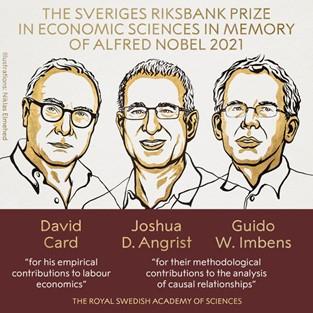Źródło: https://twitter.com/nobelprize
Professor Filip Chybalski's commentary on the Nobel Prize in Economics, which was awarded to David Card "for empirical contributions to economics of labour" and Joshua Angrist and Guido Imbens "for methodological contributions to causal analyses".
Alfred Nobel did not envisage a prize in economics in his will. This is how the Nobel Prize for Economics differs from the others. Its full name is the "Sveriges Riksbank Prize in Economic Sciences in Memory of Alfred Nobel". It was first awarded in 1969. A year later it was awarded to Paul Samuelson (USA), co-author of one of the most well-known and respected academic textbooks in economics. The second author - William D. Nordhaus (USA) - received the Nobel Prize in 2018. Other winners of this award included Austrian Friedrich A. von Hayek (1974), Americans Milton Friedman (1976), Robert Solow (1987), Harry M. Markovits (1990), or Leonid Hurwicz (2007), who spent his childhood and youth in Poland and graduated in law from Warsaw University. The story of another American Nobel Prize winner, John Nash (1994), was fantastically filmed by Ron Howard in A Beautiful Mind. The main character, suffering from schizophrenia, was played by Russell Crowe.
The 2019 Nobel Prize in Economics was awarded to husband and wife team Abhijit Banerjee and Esther Duflo of Massachussets Institute of Technology (MIT) and Michael Kremer of Harvard University for their contribution to the fight against global poverty, with their innovative research approach being highly significant. This consisted of an experiment in which a specific group of people is divided into subgroups. Analogously, for example, to medical research, different 'doses' and forms of factors are applied to each subgroup and their effect on the outcome variable is observed. This reference to the laureates of two years ago is not a coincidence. What they have in common with this year's laureates is the use of experimentation in the search for cause and effect relationships. However, these are very different kinds of experiments. In the case of this year's Nobel Prize winners - David Card (University of California), Joshua D. Angrist (Massachusetts Institute of Technology) and Guido W. Imbens (Stanford University) - it is the so-called natural experiment.
In contrast to the randomised experiment described above, the natural experiment takes advantage of opportunities, i.e. real phenomena. The role of the researcher here is reduced to observation, as he is deprived of the possibility to influence or manipulate the control variables (which is possible in a randomised experiment). The influence of certain factors on the final effect is studied under natural conditions, which means that conditions may change during the course of the experiment.
This year's Nobel Prize winners have used natural experiments to study various socio-economic phenomena. David Card, from 1991 to 1995 co-editor of two prestigious economic journals - "Econometrica" (1991-1995) and "American Economic Review" (2002-2005) - studied the impact of the minimum wage, immigration and education on the labour market. The results of his empirical analyses stand in contrast to classical or neoclassical economics, as they provide empirical arguments leading to the conclusion that a minimum wage does not necessarily lead to a decrease in the demand for labour. Card has also shown that the incomes of native-born people can increase as a result of immigration, and that the material resources of schools and the quality of education are far more important for students' future careers and earnings than we have previously thought.
Joshua Angrist and Guido Imbens, as well as the late Alan B. Krueger (Chairman of the Council of Economic Advisers in the Obama administration) showed how precise conclusions about causal relationships can be drawn from natural experiments. Angrist, together with Krueger, published a paper in 1991 in which they described the results of a study on the impact of extending the education process by one year on lifetime earnings. Noting that, according to compulsory education regulations, the month/quarter of birth determines the age at which education starts and the duration of education in the US, they saw the possibility of conducting a natural experiment. Their estimates showed that children with longer periods of compulsory education earn more during their working lives. Again in 1994, Angrist and Imbens developed a mathematical model that enabled reliable causal inference based on a natural experiment. The results of their research made it possible to identify relationships that can be interpreted in causal terms in a specific situation.
Each of this year's Nobel in Economics laureates has more than 70,000 citations according to Google Scholar (Imbens has been cited more than 80,000 times so far). Each of them received the highest annual number of citations in 2020. (Card 5881, Angrist 8766 and Imbens 7137). They have been making important contributions to the development of experimental economics and to the identification of cause-and-effect relationships in socio-economic phenomena, an issue of great importance to economists. This has always been a major challenge due to the fact that such phenomena are influenced by a huge number of factors and it is usually not possible to include all of them in empirical analyses, and their correlation is not synonymous with causality.
The fact that an observer spotted the Milky Way in the sky (as in the attached photo) is not due to the torch being switched on, but purely a coincidence of time, a coincidence of chance. Turning this torch off will not change the picture of the night sky. One breakthrough in this area was made by Clive Granger, the winner of the 2003 Nobel Prize. He defined causality (now called causality in Granger's sense) identified from time series (chronologically arranged observations of a given variable) on the basis of predicative accuracy.
Together with Paul Newbold in 1974, they published a paper in which they showed that a regression model which is good at explaining a given phenomenon, estimated on the basis of time series of the explained variable and the explanatory variables, does not imply a causal relationship between them.
The approach to causality analysis presented by the 2019 and 2021 Nobel Laureates is quite different, as it is based on experiments and the data observed in them are subjected to comparative analysis (test group vs. control group). With that said, it was Card, Angrist and Imbens who pointed out that the reality around us is full of (natural) experiments. They "only" need to be perceived, then observed, and finally subjected to advanced econometric analysis.
Photographed by Filip Chybalsk
* The following sources were used in describing the achievements of the Nobel laureates:
The Royal Swedish Academy of Sciences (2021). Press release: The Prize in Economic Sciences 2021, https://www.nobelprize.org/uploads/2021/10/press-economicsciencesprize2….
Angrist, J. D., & Keueger, A. B. (1991). Does Compulsory School Attendance Affect Schooling and Earnings? The Quarterly Journal of Economics, 106(4), 979-1014. https://doi.org/10.2307/2937954.
Imbens, G. W., & Angrist, J. D. (1994). Identification and Estimation of Local Average Treatment Effects. Econometrica, 62(2), 467-475. https://doi.org/10.2307/2951620.






